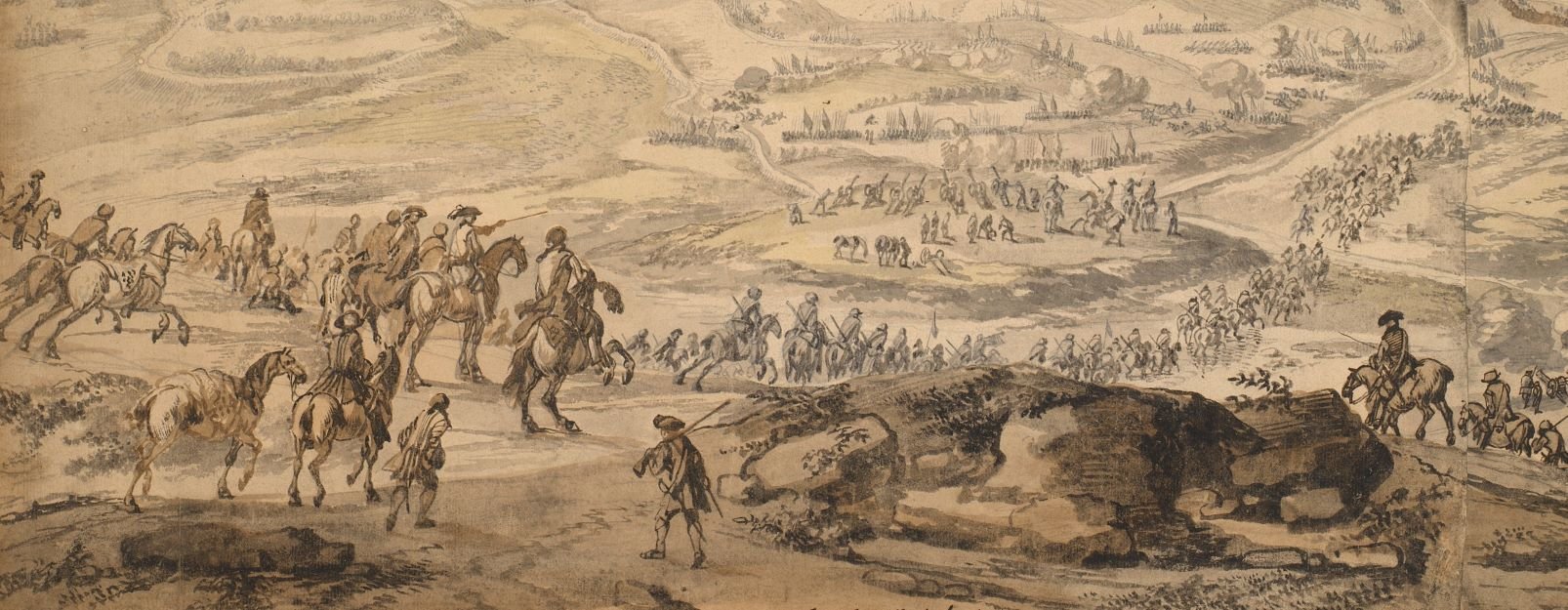
Printed and manuscript maps, prints and views of 22 seventeenth-century wars
Plan of Kaiserswerth, 1689 (Kaiserswerth, North Rhine-Westphalia, Germany) 51°18ʹ05ʺN 06°44ʹ10ʺE
1689 or laterPencil, pen, ink and watercolour on paper; laid down on coarse linen | Scale: 1:8,000 approx. | RCIN 724040
The Dutch engineer Menno van Coehoorn was present at this siege as was the draughtsman of this plan, Albert Borgard. In his diaries, Borgard notes that, after being made a Lieutenant in the Prussian Guards in January 1689, ‘In the month of June I was at the Siege of Keyserwart, which place the Brandenbhurgers, after some days’ bombardment, took from the French by capitulation’. Borgard, who signs himself here as ‘Borgad’, was of Danish birth and served as an infantry and artillery officer in the Danish army, where he was described as a ‘Conducteurer der forstaar Geometri’ – a surveyor with knowledge of trigonometrial surveying techniques. He fought in Europe under several armies and finally joined the English army after the siege of Namur in July 1692 as a Fireworker, becoming Chief Firemaster of England on 9 August 1712. He rose to become Assistant Surveyor of the Ordnance in 1718 and, in 1722, was appointed the first Colonel of the Royal Artillery. He died, aged 91, with the rank of Lieutenant-General.
For further reading, see:
F. Duncan, History of the Royal Regiment of Artillery, Woolwich, 1873, pp.83-100.
E. Baigent, ‘Borgard, Albert (1659–1751)’, Oxford Dictionary of National Biography, 2004; online edn, Jan 2008.
J. Childs, The Nine Years’ War and the British army, 1688-1697: the operations in the Low Countries, Manchester, 1991; reprint 2013, p.109-10.
Condition: one fold line; seven stud holes to left and right edges. Verso: heavy surface dirt along right edge of verso, the pattern of surface dirt is consistent with the map having formerly been tied in a roll.
Albert Borgard (1659-1751) (draughtsman) [bottom right, inside neatline:] Albert Borgad
Watermark: Fleur-de-lys in crowned shield, suspending a '4' and the letters WR below; countermark: IHS / IVILLEDARY
Condition: one fold line; seven stud holes to left and right edges. Verso: heavy surface dirt along right edge of verso, the pattern of surface dirt is consistent with the map having formerly been tied in a roll
Scale: 1:8,000 approx. Scale bar: [30 mm =] 300 Pas.
42.2 x 64.1 cm (neatline)
42.6 x 64.4 cm (image)
42.8 x 66.8 cm (sheet)
Printed title:
Le Siege / de / KEYSERSWERT / 1689 [bottom right, in an ornate cartouche decorated with the artefacts of war and surmounted by an eagle holding in its beak a spear with a tabard decorated with an indistinct design]
Annotations:
George III heading: Keyserswert 1689.
Other annotations: (Recto) [under scale bar, red ink in early nineteenth-century hand:] taken by the Elector of Brandenburg. (Verso) [bottom right, red pencil:] 3/128; [bottom, right of centre, black pencil, indistinct:] [?]4.
George III catalogue entry:
Keyserswert Plan dessiné du Siege de Keyserswert pris par l’Electeur de Brandenbourg en 1689, par Albert Borgad.
Subject(s)
Kaiserswerth, North Rhine-Westphalia, Germany (51°18ʹ05ʺN 06°44ʹ10ʺE)
Bibliographic reference(s)
E. Baigent, ‘Borgard, Albert (1659–1751)’, Oxford Dictionary of National Biography, 2004; online edn, Jan 2008
J. Childs, The Nine Years’ War and the British army, 1688-1697: the operations in the Low Countries, Manchester 1991; reprint 2013, pp. 109-10
F. Duncan, History of the Royal Regiment of Artillery, Woolwich 1873, pp. 83-100
Page revisions
21 July 2024
Current version






